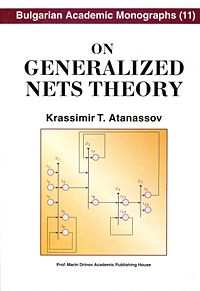Please check our Instructions to Authors and send your manuscripts to nifs.journal@gmail.com.
On Generalized Nets Theory
Jump to navigation
Jump to search

On Generalized Nets Theory is a book by Krassimir Atanassov, published in September 2007 in the series "Bulgarian Academic Monographs" of "Professor Marin Drinov" Academic Publishing House. ISBN 978-954-322-237-7.
The book presents the most interesting results in the theoretical research in the area of generalized nets, obtained after 1991 year, when the book "Generalized Nets" was published.
Table of contents
- Preface
- Chapter 1. Definitions of generalized net
- On the concept of GN
- Algorithms for transition and GN functioning
- First example: A GN model of a train station
- Short discussion on the use of GNs
- GNs and the other types of Petri nets
- Second example: GN and a Kolmogorov machine
- Chapter 2. Reduced generalized nets
- Definition of reduced GN
- Formal definition of a *-GN
- Third example: A GN-model of a subscribers' traffic of communication switching systems
- Fourth example: GN models of biological processes
- Chapter 3. Conservative extensions of generalized nets
- First conservative extensions of GNs
- Intuitionistic fuzzy GNs of type 1
- Intuitionistic fuzzy GNs of type 2
- Colour GNs
- GNs with interval activation time
- GNs with complex structure
- GNs with global memory
- GNs with optimization components
- GNs with additional clocks
- GNs with stop-conditions
- Opposite GNs
- GNs with tokens duration of "life"
- GNs with tokens possessing enhanced memory capabilities
- Two new types of intuitionistic fuzzy GNs
- Four versions of GNs with special types of initial tokens' characteristics
- First version of а GN with special types of initial tokens' characteristics
- Second version of а GN with special types of initial tokens' characteristics
- Third version of а GN with special types of initial tokens' characteristics
- Fourth and fifth versions of а GN with special types of initial tokens characteristics
- GNs in which the tokens obtain variables as characteristics
- Modified GNs
- GNs with three-dimensional structure
- Fifth example: GN, representing the functioning and the results of the work of а fuzzy Petri net
- Chapter 4. Algebraic aspect of the theory of generalized nets
- Operations and relations over GNs
- An inductive definition of the concept of а GN
- А property of the GNs
- On Hadamard's Correctness Principle
- Chapter 5. Operator aspect of the theory of generalized nets
- Operators over GNs
- Self-modifying GNs
- Sixth Example: GN models in medicine
- GN model of the human body
- GN model of the gastrointestinal system of the human body
- Chapter 6. Methodological aspect of the theory of generalized nets
- How to construct а GN
- How to check GN validity
- Algorithms for constructing of GNs on base of case studies
- First algorithm
- Second algorithm
- Third algorithm
- Fourth algorithm
- Fifth algorithm
- А GN describing the process of learning of а GN
- Chapter 7. Appendices
- Appendix 1: Index matrix
- Appendix 2: Intuitionistic fuzzy logics and intuitionistic fuzzy sets
- Bibliography
- Subject index